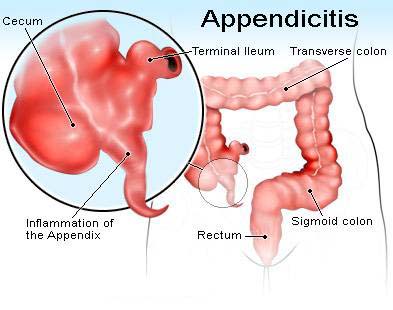What Is The Appendix ?

The appendix is a closed-ended, narrow tube up to several inches in length that attaches to the cecum (the first part of the colon) like a worm. (The anatomical name for the appendix, vermiform appendix, means worm-like appendage.) The inner lining of the appendix produces a small amount of mucus that flows through the open center of the appendix and into the cecum. The wall of the appendix contains lymphatic tissue that is part of the immune system for making antibodies. Like the rest of the colon, the wall of the appendix also contains a layer of muscle, but the muscle is poorly developed.
Physical Examination in India
Details about the abdominal pain are key to diagnosing appendicitis. The doctor will assess pain by touching or applying pressure to specific areas of the abdomen.
Responses that may indicate appendicitis include :
- Guarding. Guarding occurs when a person subconsciously tenses the abdominal muscles during an examination. Voluntary guarding occurs the moment the doctor’s hand touches the abdomen. Involuntary guarding occurs before the doctor actually makes contact.
- Rebound tenderness. A doctor tests for rebound tenderness by applying hand pressure to a patient’s abdomen and then letting go. Pain felt upon the release of the pressure indicates rebound tenderness. A person may also experience rebound tenderness as pain when the abdomen is jarred—for example, when a person bumps into something or goes over a bump in a car.
- Rovsing’s sign. A doctor tests for Rovsing’s sign by applying hand pressure to the lower left side of the abdomen. Pain felt on the lower right side of the abdomen upon the release of pressure on the left side indicates the presence of Rovsing’s sign.
- Psoas sign. The right psoas muscle runs over the pelvis near the appendix. Flexing this muscle will cause abdominal pain if the appendix is inflamed. A doctor can check for the psoas sign by applying resistance to the right knee as the patient tries to lift the right thigh while lying down.
- Obturator sign. The right obturator muscle also runs near the appendix. A doctor tests for the obturator sign by asking the patient to lie down with the right leg bent at the knee. Moving the bent knee left and right requires flexing the obturator muscle and will cause abdominal pain if the appendix is inflamed.
Women of childbearing age may be asked to undergo a pelvic exam to rule out gynecological conditions, which sometimes cause abdominal pain similar to appendicitis.
What Is Appendicitis And What Causes Appendicitis ?
Appendicitis means inflammation of the appendix. It is thought that appendicitis begins when the opening from the appendix into the cecum becomes blocked. The blockage may be due to a build-up of thick mucus within the appendix or to stool that enters the appendix from the cecum. The mucus or stool hardens, becomes rock-like, and blocks the opening. This rock is called a fecalith (literally, a rock of stool).
At other times, the lymphatic tissue in the appendix may swell and block the appendix. After the blockage occurs, bacteria which normally are found within the appendix begin to invade (infect) the wall of the appendix. The body responds to the invasion by mounting an attack on the bacteria, an attack called inflammation. An alternative theory for the cause of appendicitis is an initial rupture of the appendix followed by spread of bacteria outside the appendix.. The cause of such a rupture is unclear, but it may relate to changes that occur in the lymphatic tissue, for example, inflammation, that line the wall of the appendix.)
If the inflammation and infection spread through the wall of the appendix, the appendix can rupture. After rupture, infection can spread throughout the abdomen; however, it usually is confined to a small area surrounding the appendix (forming a peri-appendiceal abscess).
Recovery in India
With adequate care, most people recover from appendicitis and do not need to make changes to diet, exercise, or lifestyle. Full recovery from surgery takes about 4 to 6 weeks. Limiting physical activity during this time allows tissues to heal.








